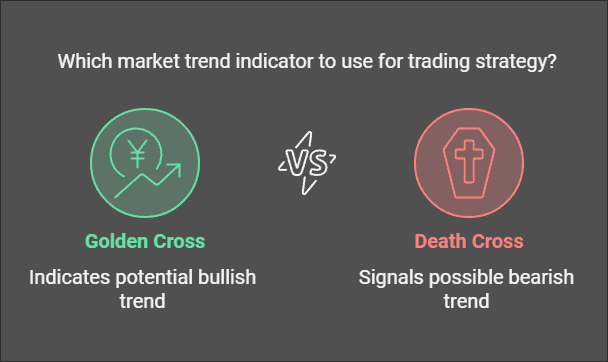
When it comes to stock trading, technical analysis serves as arguably the most fundamentally essential tool for understanding market trends and making informed decisions. Without even basic technical analysis, regular stock trading would be almost impossible to succeed at.

KEY POINTS
- Golden Cross and Death Cross – These are essential indicators in stock trading, predicting bullish and bearish market trends.
- Golden Cross – Indicates a potential shift to a bullish market, marked by a short-term moving average rising above a long-term average.
- Death Cross – Signals a possible bearish market trend, with the short-term average falling below the long-term average.
- Market Trend Analysis – These patterns reflect broader market sentiments and should be used alongside other indicators for comprehensive analysis.
- Practical Application in Trading – Guides entry and exit strategies in the market but is best used as part of an overall trading strategy.
In its most basic form, this approach leverages various statistical indicators to anticipate future price movements in the market. Among these, the concepts of the ‘golden cross’ and the ‘death cross’ are reputed for their predictive power – if used correctly, that is.
These patterns, as they are known, are identified through ‘moving averages, which help traders in various markets such as gold and silver futures, for example, gauge the momentum and potentially forecast notable shifts in market trends.
Level of Understanding
Sounds complicated? To be honest, it is. Throughout this article, we shall do our best to explain the intricate and quite technically complicated world of golden cross vs death cross, hopefully conveying their meanings in a way that would be easy to grasp. It might help if you have basic knowledge of stock trading principles, but fear not, even new traders with no experience will attain some level of understanding.
Let’s get to it, starting with the absolute raw basics.
Golden Cross vs. Death Cross – The Basics
The golden cross and death cross are solid indicators in stock trading, representing opposite market trends. The golden cross definition is when a short-term moving average (such as the 50-day average) crosses above a long-term moving average (like the 200-day average). This pattern signals a potential upward trend or bullish market, hence its name, golden cross moving average.
On the other hand, the death cross represents a bearish market signal that transpires when the short-term moving average dips below the long-term average (suggesting a downward trend).
If you are interested in becoming a trader, these patterns will become essential to read, as they offer insights into golden cross death cross dynamics and can influence investment strategies going forward.
Significance and Interpretation of Golden Cross
So, the golden cross meaning (when relating to stock trading) is basically just a strong bullish indicator. It materializes when a shorter-term moving average, like the 50-day, surges above a longer-term average, often the 200-day line. This event, labeled as the golden cross moving average, is interpreted by traders as a large sign of an emerging upward trend in a market.
Essentially, the moving average golden cross is an indicator that the market could be transitioning from a bearish to a bullish state. Traders monitor these movements closely as they often precede a period of robust market growth, making them critical for strategic investment decisions.
Understanding the Bearish Signal of Death Cross
Again, the death cross symbolizes a bearish market trend. This pattern emerges when a short-term moving average, typically the 50-day, crosses below a long-term average, such as the 200-day. The gold death cross or golden death cross signifies a market that could be shifting from bullish to bearish.
Traders view this crossover as a warning sign of potential market downturns. Understanding the death cross vs golden cross dynamics is crucial for investors, as it aids in making prudent decisions about when to enter or exit a market. Though the death cross golden cross pattern is a technical analysis tool, it is also respected for its ability to flag significant changes in market momentum.
Analyzing Golden and Death Cross
Understanding the golden cross and death cross within the broader context of market trends is vital for traders, as these patterns are far more than simple technical indicators – they reflect the underlying sentiment and momentum in the market. Or at least, they should do. As with anything in stock market trades, there are no such things as concrete, fail-safe indicators.
A golden cross meaning in stocks can suggest a turning point towards a sustained bullish phase, while a death cross golden cross indicates a shift to bearish conditions.
Using Golden and Death Cross in Trading
The practical application of the golden cross death cross concept is crucial for traders as signals that can guide when to enter or exit positions in the market. For example, a golden cross moving average may prompt traders to consider buying or increasing their position in a stock, anticipating an upward trend. On the other hand, a death cross could signal the need to sell or reduce exposure.
However, it’s important to combine these signals with other forms of analysis for a more rounded approach, in addition to other factors like trading volume and market context, to validate these patterns.
Bottom Line
If you can understand the golden cross vs death cross in stock trading, you will be equipped with a valuable tool as part of a broader analysis. However, successful trading relies on combining these indicators with other market analyses for a well-rounded approach.
Remember, the golden cross and death cross pattern can be powerful tools, but they work best when used in conjunction with a comprehensive trading strategy that includes other financial instruments, such as precious metals stocks, Bonds, and ETFs.
FAQs
What is the main difference between a golden cross and a death cross?
A golden cross indicates a bullish market trend, while a death cross suggests a bearish trend.
How reliable are golden cross and death cross indicators in predicting market movements?
While indicative, they should be used with other market analyses for a comprehensive understanding.
Can the golden cross and death cross patterns apply to all types of stocks?
Yes, these patterns can apply to various stocks but may vary in significance across different sectors.
Is the golden cross a guaranteed signal of a long-term bullish trend?
Not guaranteed, but it’s a strong indicator, especially when confirmed by high trading volume.
What should traders do when they observe a death cross in a stock’s movement?
Consider it a signal for potential caution or to reassess their investment strategy.
Article Sources
At Gold IRA Blueprint, we dive deep into the world of gold IRAs, using trusted sources to back up our insights. Our sources range from official documents to expert interviews, ensuring our content is both accurate and reliable. We also draw on research from reputable publishers to give you the most comprehensive understanding possible. Check out our editorial policy to see how we maintain our high standards for accuracy and fairness. Also make sure to check out our Financial Review Process to have a better understanding of our process.
https://www.ccn.com/education/golden-cross-vs-death-cross-how-do-they-differ
https://en.wikipedia.org/wiki/Moving_average_crossover
https://www.sofi.com/learn/content/death-cross-chart-pattern
Authors & Disclosures
- Our content is independently written and reviewed by trusted reviewers & fact-checkers.
- We can earn money by connecting you with top Gold IRA Companies. Learn how our reviews work.
- Want to learn more? Meet our authors and explore our editorial policy.













